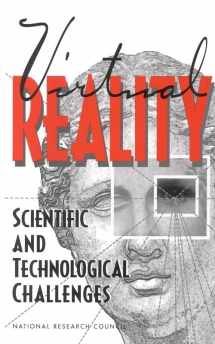
Virtual Reality: Scientific and Technological Challenges
ISBN-13:
9780309051354
ISBN-10:
0309051355
Author:
National Research Council, Computer Science and Telecommunications Board, Anne S. Mavor, Committee on Virtual Reality Research and Development, Nathaniel I. Durlach
Publication date:
1995
Publisher:
National Academies Press
Format:
Hardcover
556 pages
FREE US shipping
Book details
ISBN-13:
9780309051354
ISBN-10:
0309051355
Author:
National Research Council, Computer Science and Telecommunications Board, Anne S. Mavor, Committee on Virtual Reality Research and Development, Nathaniel I. Durlach
Publication date:
1995
Publisher:
National Academies Press
Format:
Hardcover
556 pages
Summary
Virtual Reality: Scientific and Technological Challenges (ISBN-13: 9780309051354 and ISBN-10: 0309051355), written by authors
National Research Council, Computer Science and Telecommunications Board, Anne S. Mavor, Committee on Virtual Reality Research and Development, Nathaniel I. Durlach, was published by National Academies Press in 1995.
With an overall rating of 4.3 stars, it's a notable title among other
AI & Machine Learning
(Games & Strategy Guides, Internet, Groupware, & Telecommunications, Networking & Cloud Computing, Internet & Social Media, Military Technology, Engineering, Mathematics, Computer Science) books. You can easily purchase or rent Virtual Reality: Scientific and Technological Challenges (Hardcover) from BooksRun,
along with many other new and used
AI & Machine Learning
books
and textbooks.
And, if you're looking to sell your copy, our current buyback offer is $0.38.
Description
Despite widespread interest in virtual reality, research and development efforts in synthetic environments (SE)--the field encompassing virtual environments, teleoperation, and hybrids--have remained fragmented. Virtual Reality is the first integrated treatment of the topic, presenting current knowledge along with thought-provoking vignettes about a future where SE is commonplace. This volume discusses all aspects of creating a system that will allow human operators to see, hear, smell, taste, move about, give commands, respond to conditions, and manipulate objects effectively in a real or virtual environment. The committee of computer scientists, engineers, and psychologists on the leading edge of SE development explores the potential applications of SE in the areas of manufacturing, medicine, education, training, scientific visualization, and teleoperation in hazardous environments. The committee also offers recommendations for development of improved SE technology, needed studies of human behavior and evaluation of SE systems, and government policy and infrastructure. Table of ContentsFRONT MATTERExecutive SummaryPART I OVERVIEWPART II RESEARCH AND TECHNOLOGY1 Some Psychological Considerations2 The Visual Channel3 The Auditory Channel4 Haptic Interfaces5 Position Tracking and Mapping6 Whole-Body Motion, Motion Sickness, and Locomotion Interfaces7 Speech, Physiology, and Other Interface Components8 Computer Hardware and Software for the Generation of Virtual Environments9 Telerobotics10 Networking and Communications11 Evaluation of Synthetic Environment SystemsPART III APPLICATIONS12 Specific Applications of SE SystemsReferencesAPPENDIXESA Biographical SketchesB ContributorsIndex


We would LOVE it if you could help us and other readers by reviewing the book
Book review

Congratulations! We have received your book review.
{user}
{createdAt}
by {truncated_author}


